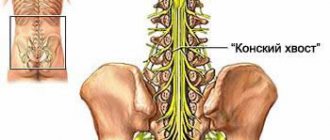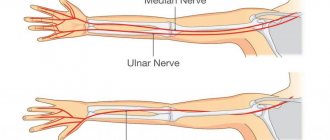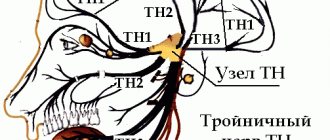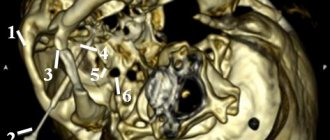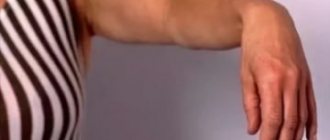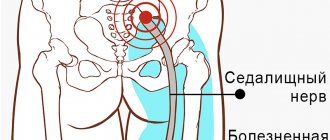Spinal nerves
The number of pairs of spinal nerves and their location correspond to the segments of the spinal cord: 8 cervical, 12 thoracic, 5 lumbar, 5 sacral, 1 coccygeal pair. They all arise from the spinal cord via the posterior sensory and anterior motor roots. The roots unite into one trunk and exit the spinal canal through the intervertebral foramen. In the area of the intervertebral foramen there are spinal nodes (ganglion spinale), which are a cluster of sensitive cells and are part of the dorsal roots. Sensitive fibers begin from the cells of the spinal ganglion, and motor fibers begin from the cells of the anterior horn. When united, the nerves become mixed. After leaving the intervertebral foramen, the spinal nerves are divided into posterior and anterior mixed branches. The posterior ones are directed to the muscles and skin of the posterior parts of the body, and the anterior ones innervate the muscles of the anterior part of the body and limbs. Uniting with each other in other sections, the nerves form the cervical, brachial, lumbar and sacral plexuses.
The cervical plexus (plexus cervicalis) (Fig. 267, 268, 269, 270, 277) is formed as a result of the union of the branches of the four upper cervical nerves and is located on the deep muscles of the neck. Coming from under the posterior edge of the sternocleidomastoid muscle, the branches of the cervical plexus are divided into sensory, motor and mixed.
Sensitive branches include: - small occipital nerve (n. occipitalis minor) (Fig. 267, 268, 270), heading to the skin of the back of the head; - large auricular nerve (n. auricularis magnus) (Fig. 268, 270), which innervates the skin of the earlobe and the convex side of the auricle; - transverse nerve of the neck (n. transversus colli), heading to the skin of the neck; - supraclavicular nerves (nn. supraclaviculares) (Fig. 267, 268, 273), passing under the collarbone and above the deltoid muscle. The motor branches go to the deep muscles of the neck and the muscles located below the hyoid bone, and also innervate the sternocleidomastoid and trapezius muscles. The mixed branch of the cervical plexus is the phrenic nerve (n. phrenicus) (Fig. 266, 268, 269, 271). The motor fibers of the phrenic nerve are directed to the diaphragm, and the sensory fibers innervate the pleura and pericardium (Fig. 266).
| Rice. 268. Scheme of spinal nerves 1 - great auricular nerve; 2 - lesser occipital nerve; 3 - supraclavicular nerves; 4 - nerves of the cervical plexus; 5 - subclavian nerve; 6 - suprascapular nerve; 7 - brachial plexus; 8 - phrenic nerve; 9 - subscapular nerve; 10 - median nerve; 11 - musculocutaneous nerve; 12 - thoracodorsal nerve; 13 - axillary nerve; 14 - long thoracic nerve; 15 - medial cutaneous nerve of the shoulder; 16 - great splanchnic nerve; 17 - radial nerve; 18 - ulnar nerve; 19 - medial cutaneous nerve of the forearm; 20 - intercostal nerves; 21 - small splanchnic nerve; 22 - nerves of the lumbar plexus; 23 - iliohypogastric nerve; 24 - ilioinguinal nerve; 25 - nerves of the sacral plexus; 26 - genital-femoral nerve; 27 - superior gluteal nerve; 28 - lower gluteal nerve; 29 - posterior cutaneous nerve of the thigh; 30 - obturator nerve; 31 - sciatic nerve |
The brachial plexus (plexus brachialis) (Fig. 268, 273, 277) is formed by the branches of the four lower cervical nerves and the anterior branch of the 1st thoracic nerve. The branches of the plexus extend to the neck between the anterior and middle scalene muscles and are directed to the axillary region. The plexus consists of a supraclavicular section, formed by short branches heading to the shoulder girdle, chest and back, and a subclavian section, which includes long branches innervating the skin and muscles of the free part of the upper limb (with the exception of the axillary nerve (n. axillaris) (Fig. . 268, 272, 273), going to the shoulder girdle).
| Rice. 269. Plexus of spinal nerves, front view 1 - cervical plexus; 2 - phrenic nerve; 3 - sympathetic trunk; 4 - median nerve; 5 - intercostal nerves; 6 - medial cutaneous nerve of the shoulder; 7 - conus medullaris; 8 - ilioinguinal nerve; 9 - lumbar plexus; 10 - lateral cutaneous nerve of the thigh; 11 - sacral plexus; 12 - femoral nerve; 13 - obturator nerve; 14 - anterior cutaneous branches of the femoral nerve | |
| Rice. 270. Plexus of spinal nerves, posterior view 1 - greater occipital nerve; 2 - lesser occipital nerve; 3 - great auricular nerve; 4 - nerves of the cervical plexus; 5 - lateral cutaneous nerve of the shoulder; 6 - posterior cutaneous branches of the thoracic nerves; 7 - nerves of the lumbar plexus; 8 - nerves of the sacral plexus | |
| Rice. 271. Nerves of the diaphragm 1 - muscle that lifts the spine; 2 - external oblique abdominal muscle; 3 - internal oblique abdominal muscle; 4 - thoracic aorta; 5 - esophagus; 6 - right phrenic nerve; 7 - inferior vena cava; 8 - left phrenic nerve |
The supraclavicular section includes: - the dorsal nerve of the scapula (n. dorsalis scapulae), which goes to the rhomboid muscle and the levator scapulae muscle; - long thoracic nerve (n. thoracicus longus) (Fig. 267, 268), innervating the serratus anterior muscle; - medial and lateral pectoral nerves (nn. pectorales medialis et lateralis) (Fig. 267, 272), going to the pectoralis major and minor muscles; - subclavian nerve (n. subclavius) (Fig. 268), which innervates the subclavian muscle; - suprascapular nerve (n. suprascapularis) (Fig. 268), next to the supraspinatus and infraspinatus muscles; - subscapularis nerve (n. subscapularis) (Fig. 268, 272), heading to the subscapularis muscle and the teres major muscle; - thoracodorsal nerve (n. thoracodorsalis) (Fig. 268, 272), which is a branch of the subscapular nerve and innervates the latissimus dorsi muscle. The subclavian region is located in the axillary region and consists of three bundles: medial, lateral and posterior. The trunks of these bundles innervate the axillary artery and are the beginning of long branches. The medial trunk includes: - the medial cutaneous nerve of the shoulder (n. cutaneus brachii medialis) (Fig. 268, 269, 272, 273), heading to the skin of the medial surface of the shoulder; - medial cutaneous nerve of the forearm (n. cutaneus antebrachii medialis) (Fig. 268, 272, 273), innervating the skin of the medial surface of the forearm; - ulnar nerve (n. ulnaris) (Fig. 268, 272, 273, 274), which is mixed. Its sensory fibers are directed to the skin of the medial parts of the hand. On the palmar surface they innervate the skin of the fifth finger and the ulnar side of the fourth finger, on the dorsal surface - the skin of the fourth and fifth fingers and the ulnar side of the third finger. Motor fibers in the forearm are directed to the flexor carpi ulnaris and the medial division of the flexor digitorum profundus. On the hand, they innervate the adductor pollicis muscle, the eminence muscles of the little finger, and the 3rd-4th lumbrical muscles.
| Rice. 272. Nerves of the shoulder girdle 1 - lateral pectoral nerve; 2 - subscapular nerve; 3 - axillary nerve; 4 - thoracodorsal nerve; 5 - musculocutaneous nerve; 6 - medial cutaneous nerve of the shoulder; 7 - radial nerve; 8 - median nerve; 9 - medial cutaneous nerve of the forearm; 10 - ulnar nerve; 11 - lateral cutaneous nerve of the forearm |
The lateral trunk includes: - the median nerve (n. medianus) (Fig. 268, 269, 272, 273, 274), which is also classified as mixed. It emerges from the lateral and medial trunks. Sensitive fibers are directed to the skin of the lateral part of the palmar surface and the skin of the 1st, 2nd and 3rd fingers, as well as to the radial side of the 4th finger and partly to the dorsum of these fingers. Motor fibers in the forearm innervate the flexors of the forearm, with the exception of the flexor carpi ulnaris and flexor digitorum profundus, and are also directed to the pronator quadratus and teres muscles. On the hand, the motor part innervates the muscles of the eminence of the thumb; - musculocutaneous nerve (n. musculocutaneus) (Fig. 268, 272, 273), which is mixed. Its branches are directed to the flexors of the anterior surface of the shoulder; - lateral cutaneous nerve of the forearm (n. cutaneus anterbrachii lateralis) (Fig. 272, 273), which is the terminal branch of the previous nerve and innervates the forearm area. The posterior trunk includes: - the radial nerve (n. radialis) (Fig. 268, 272, 273), which is mixed. Sensitive fibers are directed to the skin of the lateral parts of the dorsum of the hand and the 1st and 2nd fingers, as well as the radial side of the 3rd finger. Motor fibers innervate the extensors of the shoulder and forearm; - posterior cutaneous nerve of the shoulder (n. cutaneus brachii posterior), which is a sensitive branch of the radial nerve and is directed to the skin of the posterior surface of the shoulder; - posterior cutaneous nerve of the forearm (n. cutaneus anterbrachii posterior), which is also a sensitive branch of the radial nerve and innervates the skin of the posterior surface of the forearm. The anterior branches of the thoracic nerves do not form plexuses. Intercostal nerves (nn. intercostales) (Fig. 268, 269, 275, 277) are mixed and arise from the posterior branches. Their sensory fibers are directed to the skin of the chest and abdomen, and motor fibers are directed to the intercostal muscles, levator ribs, serratus posterior muscles, transverse thoracic muscles, as well as to the transverse and rectus abdominis muscles, external and internal oblique abdominal muscles.
| Rice. 273. Scheme of nerves of the upper limb 1 - supraclavicular nerve; 2 - brachial plexus; 3 - musculocutaneous nerve; 4 - axillary nerve; 5 - medial cutaneous nerve of the shoulder; 6 - lateral cutaneous nerve of the shoulder; 7 - ulnar nerve; 8 - median nerve; 9 - radial nerve; 10 - lateral cutaneous nerve of the forearm; 11 - medial cutaneous nerve of the forearm; 12 - superficial branch of the ulnar nerve; 13 - deep branch of the ulnar nerve; 14 - common palmar digital nerves; 15 - own palmar digital nerves |
The lumbar plexus (plexus lumbalis) (Fig. 268, 269, 270, 277) is formed by the branches of the 12th thoracic nerve and the 1st-4th lumbar nerves and lies behind and partially in the thickness of the psoas major muscle, from under the lateral edge of which they emerge branches of the lumbar plexus:
- iliohypogastric nerve (n. iliohypogastricus) (Fig. 268, 276), which is classified as mixed. Its sensory fibers go to the skin over the tensor fascia lata and the gluteus medius muscle, as well as to the skin of the suprapubic region. Motor fibers are directed to the external and internal oblique and rectus abdominis muscles; - ilioinguinal nerve (n. ilioinguinalis) (Fig. 268, 269, 276), which is also mixed, the sensory fibers of which innervate the skin of the scrotum in men and the labia in women, and the motor fibers are directed to the iliacus muscle and the quadratus lumborum muscle; - genitofemoral nerve (n. genitofemoralis) (Fig. 268, 276), which is mixed, consists of two branches. The branches of the genital branch (r. genitalis) innervate the fleshy shell of the scrotum and the muscle that lifts the testicle. The femoral branch (r. femoralis) goes to the skin below the inguinal ligament; - lateral cutaneous nerve of the thigh (n. cutaneus femoris la-teralis) (Fig. 269, 276), which is sensitive and innervates the skin of the lateral surface of the thigh; - obturator nerve (n. obturatorius) (Fig. 268, 269, 276), which is mixed. Its sensory fibers go to the skin of the lower medial surface of the thigh, and motor fibers go to the muscles of the medial thigh; - femoral nerve (n. femoralis) (Fig. 269, 276), which belongs to the mixed nerve and is the largest nerve of the lumbar plexus. The anterior cutaneous branches (rr. cutanei anteriores) (Fig. 276) are sensitive and are directed to the skin of the anterior surface of the thigh. The saphenous nerve (n. saphenus) (Fig. 276) - the longest branch of the femoral nerve - runs along the great saphenous vein and gives off many branches going to the skin of the anteromedial part of the leg and the medial parts of the dorsum of the foot. The muscular branches (rr. musculares) of the femoral nerve are directed to the psoas major muscle, iliacus muscle, quadriceps and sartorius muscles of the thigh.
| Rice. 274. Nerves of the hand 1 - ulnar nerve; 2 - median nerve; 3 - superficial branches of the ulnar nerve; 4 - common palmar digital nerves; 5 - own palmar digital nerves | |
| Rice. 275. Intercostal nerves 1 - spinal cord; 2 - spinal nerve; 3 - central intercostal nerves; 4 - thoracic aorta; 5 - lateral cutaneous thoracic branch; 6 - external intercostal muscle; 7 - anterior cutaneous thoracic branch; 8 - internal intercostal muscle |
The sacral plexus (plexus sacralis) (Fig. 268, 269, 270, 277) is formed by the anterior branches of the 4th-5th lumbar nerves, the anterior branches of the sacral nerves and the coccygeal nerve. The branches are divided into short and long and are directed to the greater sciatic foramen, forming a triangular plate located on the anterior surface of the piriformis muscle.
| Rice. 276. Scheme of nerves of the lower limb 1 - iliohypogastric nerve; 2 - obturator nerve; 3 - ilioinguinal nerve; 4 - femoral nerve; 5 - genital-femoral nerve; 6 - lateral cutaneous nerve of the thigh; 7 - sciatic nerve; 8 - posterior cutaneous nerve of the thigh; 9 - common peroneal nerve; 10 - tibial nerve; 11 - medial cutaneous nerve of the calf; 12 - deep peroneal nerve; 13 - saphenous nerve; 14 - superficial peroneal nerve; 15 - lateral cutaneous nerve of the calf; 16 - sural nerve; 17 - medial and lateral plantar branches |
Short branches include: - muscular branches (rr. musculares), innervating the quadratus femoris, superior and inferior gemellus muscles, piriformis and obturator internus muscles; - superior gluteal nerve (n. gluteus superior) (Fig. 268), which innervates the tensor fascia lata, the gluteus medius and minimus muscles; - lower gluteal nerve (n. gluteus inferior) (Fig. 268), heading to the gluteus maximus muscle; - the genital nerve (n. genitalis) is classified as mixed. Sensory fibers innervate the skin of the perineum and external genitalia, and motor fibers innervate the muscles of the perineum. Long branches include: - posterior cutaneous nerve of the thigh (n. cutaneus femoris posterior) (Fig. 268, 276), which is sensitive and goes to the skin of the posterior surface of the thigh; - sciatic nerve (n. ischiadicus) (Fig. 268, 276), which belongs to the mixed nerve and is the largest nerve in the human body. Many branches extend from it, heading to the muscles of the posterior thigh. The nerve itself descends to the upper part of the popliteal fossa, where it divides into the tibial and peroneal nerves. The tibial nerve (n. tibialis) (Fig. 276) runs along the posterior tibial artery between the deep and superficial flexors of the tibia and behind the medial malleolus of the tibia it enters the plantar surface of the foot. In the area of the popliteal fossa, the tibial nerve gives off the following branches: - the medial cutaneous nerve of the calf (n. cutaneus surae medialis) (Fig. 276) is directed to the skin of the posteromedial surface of the leg. In the lower part of the leg it unites with the lateral cutaneous nerve of the calf. Together they form the sural nerve (n. suralis) (Fig. 276), passing behind the lateral malleolus and innervating the lateral parts of the dorsum of the foot; — muscular branches (rr. musculares) innervate the muscles of the posterior surface of the lower leg.
| Rice. 277. Projection of nerve plexuses onto the spinal column 1 - cervical plexus; 2 - brachial plexus; 3 - intercostal nerves; 4 - lumbar plexus; 5 - sacral plexus |
On the lower leg, the tibial nerve gives off the following branches: - medial calcaneal branches (rr. calcanei medialis) are directed to the skin of the medial parts of the heel; — muscular branches (rr. musculares) innervate the deep layer of the posterior group of muscles of the lower leg. On the surface of the foot, the tibial nerve is divided into medial and lateral plantar branches (rr. plantares medialis et lateralis) (Fig. 276), which are mixed and follow in the same direction as the plantar arteries. Sensitive fibers of the medial plantar nerve are directed to the skin of the medial part of the sole of the foot and to the skin of the I, II, III, IV fingers. Motor fibers are directed to the flexor digitorum brevis muscle, the abductor hallucis muscle and the 1st-2nd lumbrical muscles. The motor fibers of the lateral plantar nerve innervate the flexor of the little toe brevis, the abductor of the little toe, the adductor hallucis muscle, the quadratus plantae muscle, the interosseous muscles and the 3-4th lumbrical muscles. The common peroneal nerve (n. fibularis communis) (Fig. 276) is a mixed nerve and in the lateral part of the popliteal fossa is divided into the superficial and deep peroneal nerves. The main branches of the common peroneal nerve are: - the lateral cutaneous nerve of the calf (n. cutaneus surae late-ralis) (Fig. 276), heading to the skin of the posterolateral parts of the leg and uniting with the medial cutaneous nerve of the calf; - superficial peroneal nerve (n. fibularis superficialis) (Fig. 276), which is mixed. Its sensory fibers innervate most of the skin on the dorsum of the foot, and motor fibers innervate the long and short peroneal muscles; - deep peroneal nerve (n. fibularis profundus) (Fig. 276), following along the tibial artery. Its sensitive branch gives off many branches into the skin of the dorsum of the foot in the area of the first interdigital space. Motor fibers innervate the anterior group of muscles of the lower leg and the muscles of the dorsum of the foot.
| Rice. 278. Area of innervation of the trunk, front view I - cutaneous branches of the cervical plexus; II - supraclavicular nerves; III - lateral cutaneous nerve of the forearm; IV - medial cutaneous nerve of the shoulder; V - anterior cutaneous branches of the intercostal nerves; VI - lateral cutaneous branches of intercostal nerves; VII - lateral cutaneous branch of the iliohypogastric nerve; VIII - anterior cutaneous branches of the iliohypogastric nerve; IX - ilioinguinal nerve; X - lateral cutaneous nerve of the thigh; XI - branches of the genital-femoral nerve; XII - branches of the sacral plexus; XIII - anterior cutaneous branches of the femoral nerve; XIV - cutaneous branch of the obturator nerve | |
| Rice. 279. Areas of innervation of the body, rear view I - suprascapular nerve; II - lateral cutaneous nerve of the forearm; III - lateral cutaneous branches of the thoracic nerves; IV - medial cutaneous nerve of the shoulder; V - posterior cutaneous nerve of the shoulder; VI - lateral cutaneous branches of intercostal nerves; VII - medial cutaneous branches of the thoracic nerves; VIII - branches of the lumbar nerves; IX - medial cutaneous branches of the sacral nerves; X - lateral cutaneous branch of the iliohypogastric nerve; XI - lateral cutaneous nerve of the thigh; XII - branches of the posterior cutaneous nerve of the thigh | |
| Rice. 280. Areas of innervation of the upper limb A - palmar surface; B - dorsal surface: I - transverse nerve of the neck; II - subclavian nerves; III - lateral cutaneous nerve of the forearm; IV - branches of the thoracic nerves; V - medial cutaneous nerve of the shoulder; VI - posterior cutaneous nerve of the shoulder; VII - lateral cutaneous nerve of the forearm; VIII - medial cutaneous nerve of the forearm; IX - branches of the median nerve; X - branches of the ulnar nerve; XI - branches of the radial nerve; XII - deep branches of the median nerve; XIII - deep branches of the ulnar nerve; XIV - branches of intercostal nerves; XV - posterior cutaneous nerve of the forearm; XVI - deep branches of the radial nerve | |
| Rice. 281. Areas of innervation of the lower limb A - anterior surface; B - posterior surface: I - lateral cutaneous branch of the iliohypogastric nerve; II - branches of the genital-femoral nerve; III - ilioinguinal nerve; IV - lateral cutaneous nerve of the thigh; V - cutaneous branch of the obturator nerve; VI - anterior cutaneous nerve of the thigh; VII - branches of the saphenous nerve; VIII - branches of the common peroneal nerve; IX - branches of the superficial peroneal nerve; X - branches of the sural nerve; XI - branches of the deep peroneal nerve; XII - branches of the lumbar nerves; XIII - medial cutaneous branches of the sacral nerves; XIV - posterior cutaneous nerve of the thigh; XV - branches of the tibial nerve | |
| Rice. 282. Areas of innervation of the head and neck I - branches of the frontal, orbital and trigeminal nerves; II - branches of the zygomatic, infraorbital, maxillary and trigeminal nerves; III - branches of the greater occipital nerve; IV - branches of the auriculo-occipital, mental, mandibular and trigeminal nerves; V - branches of the lesser occipital nerve; VI - branches of the greater auricular nerve; VII - subcutaneous branches of the dorsal nerve of the scapula; VIII - transverse nerve of the neck; IX - supraclavicular nerves |
Ultrasound examination of the peripheral nervous system
Ultrasound scanner HS70
Accurate and confident diagnosis.
Multifunctional ultrasound system for conducting studies with expert diagnostic accuracy.
Ultrasound examination of the peripheral nervous system first began to be used to diagnose diseases of the nerve trunks in the late 90s of the last century [1]. With the beginning of the use of this method, its undeniable advantages over other diagnostic methods became clear. Electrophysiological methods, such as electromyography and neuromyography, are traditionally recognized as the “gold standard” for identifying pathology of the peripheral nervous system. However, it should be noted that the information obtained during the above examinations does not provide an idea of the state of the surrounding tissues, does not indicate the nature and cause of damage to the nerve trunk, and does not always accurately reflect the localization of changes [2, 3]. At the same time, it is this information that helps determine the tactics of conservative or surgical treatment.
The introduction of ultrasound sonography into clinical practice has successfully filled the gaps in the diagnosis of peripheral nerve diseases. This article presents the experience of ultrasound examination of peripheral nerves of the upper and lower extremities, accumulated in our clinic.
Ultrasound anatomy of normal peripheral nerves
For ultrasound studies, sensors with a frequency of 7-17 MHz are used, but in some cases it is necessary to use transducers with a lower frequency - 3-5 MHz. During the scanning process, the anatomical integrity of the nerve trunk, its structure, the clarity of the contours of the nerve and the condition of the surrounding tissues are assessed. All of the above points must be reflected in the study protocol. If pathological changes in the structure of the nerve are detected, the type of damage (complete or partial), the zone and degree of compression of the nerve trunk are indicated (the decrease in the diameter of the nerve and the cause of the compression are noted). If a space-occupying formation is detected, its size and structure, contours, relationship with surrounding soft tissues, and the presence or absence of blood flow are described.
It is advisable to begin ultrasound examination of peripheral nerves with a transverse projection at the point where the nerve trunk is most easily identified, then moving in the proximal and distal directions, assessing the structure of the nerve along its length [3-5].
The image of a nerve has a number of characteristic features. In the transverse projection, it looks like an oval or round formation with a clear hyperechoic contour and an internal heterogeneous ordered structure (“salt and pepper”, “honeycomb”) [4, 6, 7]. In the longitudinal projection, the nerve is located in the form of a linear structure with a clear echogenic contour, in which hypo- and hyperechoic stripes regularly alternate - “electric cable” [7]. The thickness of peripheral nerves is variable and ranges from 1 mm for the digital nerves to 8 mm for the sciatic nerve.
The key to a successful ultrasound examination is a good knowledge of the anatomy of the area being examined.
The main nerve trunks accessible to ultrasound examination in the upper limb are the radial, median and ulnar nerves.
The radial nerve is the largest branch of the posterior portion of the brachial plexus. The nerve is visualized on the posterior and lateral surfaces of the shoulder, where it accompanies the brachial artery. In the middle third of the shoulder, the radial nerve bends around the humerus and is directly adjacent to it in the spiral canal (Fig. 1).
Rice. 1.
Transverse sonogram of the radial nerve (short arrows) at the level of the spiral canal of the humerus (long arrows - outline of the humerus).
It is from the spiral canal that it is most advisable to begin the process of scanning the radial nerve. As a rule, sensors with a frequency of 9-17 MHz are used for this, and the study is carried out mainly in the transverse projection. Further, immediately anterior to the lateral epicondyle of the humerus, n. radialis is divided into sensory (or superficial) and motor (deep) branches and the posterior interosseous nerve (Fig. 2).
Rice. 2.
Transverse sonogram at the level of the distal shoulder. Division of the radial nerve into superficial and deep branches (arrows).
The superficial branch runs along the medial edge of the brachioradialis muscle and is accompanied by the radial artery and vein. In this place, the nerve is most accessible to ultrasound examination, but only if high-frequency sensors are used (over 15 MHz), since the diameter of this branch is very small.
The deep branch of the radial nerve passes directly into the supinator, here the nerve is also accessible to visualization due to the difference in sonographic structure between it and the surrounding muscle.
In the distal section on the extensor surface of the forearm n. radialis (its superficial branch) ends in division into 5 dorsal digital nerves. Ultrasound examination of digital nerves can only be performed using high-frequency transducers, and even then, clear sonographic images of these structures are rarely obtained.
The median nerve is formed from the lateral and medial bundles of the brachial plexus. On the shoulder n. medianus is located in the medial groove of the biceps muscle anterior to the brachial artery. The median nerve is the largest nerve of the upper extremity, so its visualization is not difficult, but the easiest way to obtain an ultrasound image of the nerve is in the carpal tunnel, where it is located superficially, and also at the level of the elbow joint. In the latter case, it is advisable to use a vascular bundle as a marker. In the area of the elbow joint, the median nerve is located medial to the more deeply located brachial artery and vein (Fig. 3).
Rice. 3.
The median nerve at the level of the elbow joint in transverse view (short arrows). The brachial artery is visualized nearby (long arrow).
In the proximal forearm, the nerve usually passes between the two heads of the pronator teres muscle. In the area of the wrist joint, the median nerve is located under the palmaris longus tendon and between the flexor tendons, passing under the flexor retinaculum onto the hand through the so-called carpal tunnel. The common palmar digital nerves (there are three of them) are formed by branching the main trunk of the median nerve at the level of the distal end of the flexor retinaculum.
The ulnar nerve is the main branch of the medial bundle of the brachial plexus. On the shoulder n. ulnaris does not produce branches. In the area of the elbow joint, the nerve passes through the cubital canal formed by the medial epicondyle of the humerus and the olecranon process. Here the ulnar nerve is adjacent directly to the bone and is covered on top only by fascia and skin. When performing an ultrasound examination of the elbow joint, care should be taken to ensure that the patient’s arm is positioned freely and is not bent. This is important because when the elbow is flexed to 90 degrees, the diameter of the nerve decreases due to its stretching.
On the forearm n. ulnaris is usually located between the two heads of the flexor carpi ulnaris, and in the distal forearm the nerve lies between the flexor carpi ulnaris tendon medial and lateral to the ulnar artery and vein. The ulnar nerve enters the hand through the ulnar nerve canal called Guyon's canal. As it passes through the canal, the ulnar nerve is accompanied by the artery and vein of the same name. In the distal part of Guyon's canal, the nerve divides into a deep motor branch and a superficial sensory branch, and it is the superficial branch that continues to accompany the ulnar artery, which makes it easier to navigate during ultrasound examination.
In the lower extremity, ultrasound scanning can easily identify the sciatic nerve and its branches. Foreign literature also describes sonographic examination of the femoral nerve. It should be noted that visualization of this peripheral nerve is difficult and the best acoustic window is the groin area, where the nerve accompanies the femoral artery and vein.
The sciatic nerve is the largest peripheral nerve in the human body. In fact, it consists of two large trunks: the common peroneal nerve is located outside, and the tibial nerve is medial. The sciatic nerve exits the pelvic cavity through the greater sciatic foramen under the piriformis muscle.
Already in the gluteal region, the nerve is accessible to visualization; you just need to correctly determine the frequency of the sensor used: if there is sufficient muscle mass, it is advisable to use sensors with a frequency of 2-5 MHz; if the muscle mass in the gluteal region is not expressed, you can use sensors with a higher frequency - 5-9 MHz. In the area of the gluteal fold, the sciatic nerve is located close to the lata fascia of the thigh, moves laterally and then lies under the long head of the biceps femoris muscle, located between it and the adductor magnus muscle (Fig. 4).
Rice. 4.
Sciatic nerve (longitudinal view, panoramic scan) in the middle third of the thigh (arrows).
In the distal parts of the thigh, usually in the upper corner of the popliteal fossa, the nerve is divided into two branches: a thicker medial one - the tibial nerve and a thinner lateral one - the common peroneal nerve. It is from this area that it is best to begin an ultrasound examination of the sciatic nerve and its branches.
The common peroneal nerve, having separated from the main trunk, descends laterally under the biceps femoris muscle to the head of the femur. In the area of the head of the fibula, the nerve is located superficially, covered only by fascia and skin, here it is also easily accessible for visualization (Fig. 5).
Rice. 5.
Longitudinal sonogram of the common peroneal nerve (arrows) at the level of the fibular head (F).
Next, the common peroneal nerve penetrates the thickness of the proximal part of the peroneus longus muscle and divides into its two terminal branches - the superficial peroneal nerve and the deep peroneal nerve. Visualization of the terminal branches of the common peroneal nerve is difficult due to their small diameter and the lack of anatomical markers as they pass through the thickness of the calf muscles. The superficial peroneal nerve divides into terminal branches (dorsal branches of the foot) on the lateral surface of the lower third of the leg. The deep peroneal nerve passes to the anterior surface of the leg and here, located laterally, accompanies the anterior peroneal vessels. On the dorsum of the foot, the nerve enters under the lower extensor retinaculum and under the tendon of the long extensor of the first finger. Here it divides into terminal branches. To visualize the common peroneal nerve and its branches, it is more convenient to use sensors with a frequency of 9-17 MHz.
The tibial nerve in its direction is a continuation of the sciatic nerve. In the popliteal fossa, the nerve is located above the popliteal vein and artery and somewhat outward from them (Fig. 6).
Rice. 6.
Sonograms of the tibial nerve in the popliteal fossa (arrows). The popliteal vascular bundle is visualized - vein (V) and artery (A).
A)
Longitudinal sonogram.
b)
Transverse sonogram.
On the lower leg, the tibial nerve enters between the heads of the gastrocnemius muscle and accompanies the posterior tibial vessels, passing under the soleus muscle. The tibial nerve enters the foot through the so-called “tarsal canal” or medial malleolar canal, formed medially by the medial malleolus and laterally by the fascia of the flexor retinaculum. This fibrous tunnel is similar in structure to the carpal tunnel on the hand. At the exit from the tarsal canal, the nerve divides into terminal branches - the medial and lateral plantar nerves. The tibial nerve is best examined in the popliteal fossa and proximal tibia, as well as at the level of the medial malleolus (Fig. 7). In the middle third of the leg, the nerve is located quite deep and its image is difficult to differentiate from the surrounding tissues.
Rice. 7.
Transverse sonogram of the tibial nerve at the level of the medial malleolus (arrows). The posterior tibial veins (V) and artery (A) are visualized.
In the lower leg, the tibial nerve gives off cutaneous and muscular branches. Of all the branches, the sural (sural) nerve is most often accessible to visualization (Fig. 8). It is located outward from the small saphenous vein and accompanies it to the lateral malleolus, where it divides into terminal cutaneous branches.
Rice. 8.
Sural nerve (arrows). Projections at the level of the middle third of the leg.
A)
Longitudinal projection.
b)
Transverse projection.
To study the tibial nerve and its branches, sensors with a frequency of up to 9-17 MHz are used.
Ultrasound diagnosis of peripheral nerve diseases
Nerve damage
Traumatic nerve injuries can be divided into two large groups: damage with complete or partial disruption of the anatomical integrity of the nerve and damage to the internal structure of the nerve trunk while maintaining the integrity of the outer sheath of the nerve. The ultrasound picture of nerve injuries has characteristic signs depending on the type of damage and is common to any peripheral nerve. The reasons for the violation of the integrity of the nerve trunk may be different. In our practice, we most often encounter the consequences of injuries: intersection of a nerve as a result of an incised wound, damage by bone fragments or pinching of the nerve between them during displaced fractures, compression of the nerve by scar tissue or callus. In addition, iatrogenic damage to the nerve can occur during closed or open reposition of fragments with subsequent fixation with a plate, during surgery on soft tissues adjacent directly to the nerve trunk.
In the upper extremity, the most common injuries to the radial nerve are associated with a fracture of the humerus, which is primarily explained by the close apposition of the nerve to the bone as it passes through the spiral canal of the humerus. On the lower limb, the most vulnerable area in this regard is the head of the fibula, where the common peroneal nerve is directly adjacent to it.
A conclusion about a violation of the anatomical integrity of the nerve can be made on the basis of visualization of the distal and proximal ends of the nerve with a clearly visible diastasis between them. Moreover, in the first days after the injury, the severed nerve segments, as a rule, are not changed, and only after some time (from 1 to 12 months) does a post-traumatic neuroma most often form at the proximal end of the damaged nerve trunk (Fig. 9). The distal end of a completely damaged nerve becomes thinner, and in some cases traumatic neuromas can form in it.
Rice. 9.
Terminal post-traumatic neuroma of the ulnar nerve. The arrow indicates the proximal end of the damaged nerve, ending in an oval hypoechoic formation with a clear contour—neuroma. Longitudinal sonogram.
Traumatic neuromas, depending on the location of the formation and the cause that caused them (complete or partial rupture), are divided into terminal and intra-trunk. The structure of the neuroma is hypoechoic and homogeneous, the size of the neuroma depends on the size of the damaged nerve and the amount of nerve tissue involved in the damage, the formation has clear contours and is avascular. If the integrity of the nerve is partially damaged in the damaged nervous tissue, as mentioned above, an intra-trunk neuroma can form (Fig. 10). In this case, the formation is visualized directly in the nerve trunk; it has the same ultrasound characteristics as with a complete break of the trunk; the size of the neuroma is variable and can reach several centimeters in length. The ultrasound report must indicate the diastasis between the ends of the damaged nerve and the structure of the proximal and distal ends, the size of the neuroma, and its location.
Rice. 10.
Intrastem neuroma of the median nerve. Short arrows indicate the proximal and distal ends of the damaged nerve; the hypoechoic formation is surrounded by perineurium and has clear contours—neuroma. Longitudinal sonogram.
In case of contusion of a nerve or its traction, if the outer sheath remains intact, the internal structure of the nerve trunk changes. There is a loss of differentiation into individual fibers, the nerve becomes hypoechoic, thickened, with an unclear contour. The ultrasound signs listed above are detected directly at the site of damage; in the proximal and distal directions, the nerve trunk, as a rule, is not changed. At the site of pinching of the nerve trunk between bone fragments or metal structures, thinning of the nerve directly at the site of the lesion and loss of an ordered echostructure are noted (Fig. 11). The same picture can be seen when compressed by scar tissue or callus (while maintaining the integrity of the nerve). Proximal to the place of compression, the diameter of the nerve increases due to the thickening of individual nerve bundles in its composition. In this case, the trunk has unclear contours and a structure of reduced echogenicity. The described ultrasound signs are caused by swelling of the nerve segment proximal to the compressed area. Distal to the site of injury, the structure of the nerve may not be changed.
Rice. eleven.
Entrapment of the deep branch of the radial nerve (short arrows) at the level of the proximal forearm by a bone fragment (long arrow). The nerve has a hypoechoic homogeneous structure, thickened, and there is no differentiation into individual fibers. Panoramic scanning.
Peripheral nerve compression syndromes (tunnel syndromes)
Peripheral nerves of the extremities can be subject to compression in natural fibrous canals, when located in the thickness of muscle tissue and when adjacent to bone. The following localizations of potential compression of nerve trunks have been described in the upper limb. For the radial nerve, this is the spiral canal and m. supinator of the forearm. The median nerve can become entrapped as it passes between the heads of the pronator teres and in the carpal tunnel. For the ulnar nerve, the most likely sites for carpal tunnel syndrome are the cubital canal and Guyon's canal. In the lower extremity, the common peroneal nerve is most often compressed at the level of the fibular head; the tibial nerve may be compressed distally as it passes through the tarsal canal.
Carpal tunnel syndrome is the most common peripheral nerve compression syndrome. This pathology has a characteristic clinical picture and is easily diagnosed. Ultrasound can help confirm compression of the median nerve in the carpal tunnel. The main ultrasound signs of this tunnel syndrome include: thickening of the median nerve proximal to the carpal tunnel, flattening or decreased height of the nerve in the distal carpal tunnel, and curvature of the flexor retinaculum. In the proximal parts, the median nerve loses its differentiation into fibers, and its structure becomes hypoechoic (Fig. 12). A number of foreign studies devoted to the problem of ultrasound diagnosis of “carpal tunnel” syndrome emphasize the need for quantitative assessment of changes in the median nerve. In our practice, we use two main criteria: an increase in the cross-sectional area of the median nerve over 0.11 cm², measured at the level of the pisiform bone, and a flattening coefficient, defined as the ratio of the maximum width of the nerve to its height (values above 3.3 are considered pathological) . The appearance of intraneural hypervascularization at the site of compression of the median nerve when examined in color-coding mode may also indicate the development of “carpal tunnel” syndrome.
Rice. 12.
Compression of the median nerve in the carpal tunnel. The location of nerve compression is indicated by a light arrow. Above the place of compression (dark arrow), the nerve is thickened, its contours are unclear, and there is a thickening of individual nerve bundles within the nerve. Longitudinal sonogram.
The second most common is ulnar nerve compression syndrome in the cubital tunnel. True entrapment in the ulnar groove occurs when the nerve is compressed by scar tissue, callus, exostoses or soft tissue formations, such as an organized hematoma, intraneural ganglia and intraarticular ganglia, and accessory ulnar muscle. External nerve compression may develop in the presence of predisposing factors: a shallow groove of the ulnar nerve, prolonged pressure on the cubital canal area, or subluxation of the nerve in patients who are in a coma or during prolonged anesthesia. Repeated dislocation of the ulnar nerve with its displacement towards the medial epicondyle of the humerus can cause damage to the nerve or provoke permanent trauma.
Ultrasound examination of the ulnar nerve if compression of the nerve in the cubital canal is suspected begins in the transverse projection from the distal shoulder. Usually in this area the nerve has an oval shape; when passing through the cubital canal it becomes round. It should be emphasized again that patients may experience a slight decrease in the echogenicity of the ulnar nerve in this area and a slight increase in its size without clinical symptoms of neuropathy. Unlike healthy individuals, in patients with cubital tunnel syndrome, an increase in the diameter of the ulnar nerve is found at the level of the medial humeral condyle.
After examining the nerve in the cubital canal in the transverse and longitudinal projections, the sensor is moved distally and the structure of the nerve in the proximal forearm is assessed. The main ultrasound signs of ulnar nerve compression syndrome in the cubital canal include flattening of the nerve directly at the site of compression, thickening above this zone, loss of internal differentiation of the nerve into separate bundles, swelling of the surrounding soft tissues and hypervascularization.
With chronic trauma to the ulnar nerve in the cubital canal, the clinical manifestations do not differ from those with compression of the nerve in this area, and ultrasound data will have other characteristic signs. The main one is diffuse thickening of the nerve at the level of the cubital canal (Fig. 13). In addition, one can detect an increase in the size of individual nerve bundles within the nerve, blurring of the contour of the nerve due to swelling of the surrounding soft tissues.
Rice. 13.
Neuropathy of the ulnar nerve at the level of the cubital canal. Longitudinal sonogram.
Compression of the ulnar nerve in Guyon's canal is much less common than cubital tunnel syndrome. The main causes of entrapment of the ulnar nerve in Guyon's canal are external compression by various formations: lipoma, intra-articular ganglion, aneurysm of the ulnar artery. This type of tunnel syndrome is rare, and the ultrasound findings of compression of the ulnar nerve in Guyon's canal are consistent with those described above for other compression syndromes.
When examining the medial ankle joint, it is necessary to remember about such a type of pathology as tarsal tunnel syndrome. This type of tunnel syndrome is associated with compression of the tibial nerve in the tarsal tunnel. The tarsal canal is similar in structure to the carpal canal on the hand. The flexor tendons and neurovascular bundle are contained in a fairly tight space between the medial malleolus and the flexor retinaculum. When the pressure in this space increases, compression of the tibial nerve occurs, which is clinically manifested by pain and paresthesia in the medial part of the foot. Ultrasound diagnosis of this tunnel syndrome is based on identifying additional formations in the tarsal canal: this is an accumulation of fluid, an intraarticular ganglion, which causes compression and flattening of the tibial nerve. Above the compression zone, there is thickening of the nerve trunk with ultrasound signs of its edema.
Space-occupying formations of peripheral nerves
Schwannomas and neurofibromas are the most common peripheral nerve tumors. It should be noted that their ultrasound signs are similar. Hypoechoic formations of oval or fusiform shape are identified, oriented along the long axis of the nerve and giving the effect of dorsal enhancement (Fig. 14). The contours of the formation are clear, even, and sometimes its capsule can be located. Ultrasound examination can reveal heterogeneity and fluid inclusions in the structure of the tumor. The size of the formations ranges from 2 to 5 cm. In the color Doppler mode, abundant vascularization is usually detected in tumors. Since, as noted above, neurofibromas and schwannomas have similar sonographic characteristics, the histological diagnosis is not indicated in the ultrasound report, limiting itself to a detailed description of the identified formation.
Rice. 14.
Neurofibroma of the tibial nerve at the level of the popliteal fossa is a formation with clear contours, fusiform shape, hypoechoic structure.
A)
Panoramic scanning.
b)
With color Doppler mapping, blood flow is determined in the formation.
Malignant peripheral nerve tumors typically affect large nerve trunks, such as the sciatic nerve or brachial plexus. In addition, patients with malignant tumors are more likely to have definite neurological symptoms compared to patients with benign tumors. Ultrasound signs such as a tumor size of more than 5 cm, blurred contours, heterogeneity of the structure with the presence of calcifications and the reaction of surrounding tissues in the form of edema and infiltration most likely indicate a malignant process. The characteristics listed above (with the exception of indications of invasive growth) are not specific and do not allow us to draw an unambiguous conclusion about the nature of the tumor.
Morton's neuroma (perineural fibrosis, focal traumatic neuritis of the plantar nerve) is a fibrous thickening of the interdigital nerve and belongs to tumor-like lesions of the nerve trunks. The predominant localization of this tumor between the 3rd and 4th metatarsal bones has an anatomical basis: a kind of nerve plexus is formed here from the branching of the common plantar nerve of the third interdigital space and the branches of the anastomosis from the lateral plantar nerve. Ultrasound examination of the interdigital spaces between the toes is best done from the plantar surface, with the sensor installed in the transverse plane at the level of the metatarsal heads. The experience of our research shows that a transverse examination of the foot alone is not enough, therefore longitudinal ultrasound scanning in this area is also necessary. For research, it is advisable to use sensors with a frequency of at least 12 MHz. The normal interdigital space is characterized by the presence of echogenic material, including fat and connective tissue. The neuroma has a round or fusiform shape and a hypoechoic structure, defined in the lower part of the intermetatarsal space between the heads of the metatarsal bones (Fig. 15). An attempt should always be made to establish a connection with the interdigital nerve, which immediately increases the specificity of the sonographic examination. Due to the small size of the plantar nerves, this is not always achieved. A neuroma can be confused with inflammation in the adjacent metatarsal bursa. Ultrasound differences are that the metatarsal bursa is located anterior to the interdigital nerve between the metatarsal heads and when the bursa is inflamed, there is usually a fluid component in it. In addition, the clinical symptoms of Morton's neuroma are characteristic enough to suspect this particular disease.
Rice. 15.
Morton's neuroma. A hypoechoic formation (dark arrow) is located between the metatarsal heads (white arrows). Longitudinal sonogram.
Conclusion
Ultrasound examination of the peripheral nervous system is becoming increasingly important in clinical practice every year. The undeniable advantages of sonography compared to other imaging methods are the relative cheapness of the study and the ability to repeat it the required number of times. During the examination, a specialist can assess the structure of the nerve trunk along its length and the condition of the surrounding tissues, and conduct a series of dynamic tests. The main disadvantage of the ultrasound method is the subjectivity in assessing the data obtained, associated with various practical skills and experience of specialists. We hope that this publication will make a modest contribution to the introduction of ultrasound neurology into widespread clinical practice and will help doctors better navigate the issues of diagnosing diseases of the peripheral nervous system.
Literature
- Fornage BD Peripheral nerves of the extremities: imaging with US // Radiology. 1988. V. 167. N1. R. 179-182.
- Gruber H., Peer S., Meirer R. et al. Peroneal Nerve Palsy Associated with Knee Luxation: Evaluation by Sonography-Initial Experiences // Am. J. Roentgenol. 2005. V. 185. P. 1119-1125.
- Peer S., Bodner G. High-Resolution Sonography of the Peripheral Nervous System // 2003. Springer. 140 p.
- Eskin N.A., Golubev V.G., Bogdashevsky D.R. and others. Echography of nerves, tendons and ligaments // SonoAce International. 2005. Vol. 13. pp. 82-94.
- Bodner G., Buchberger W., Schocke M. et al. Radial Nerve Palsy Associated with Humeral Shaft Fracture: Evaluation with US-Initial Experience // Radiology. 2001. V. 219. N3. P. 811-816.
- Mironov S.P., Eskin N.A., Golubev V.G. and others. Ultrasound diagnosis of pathology of tendons and nerves of the extremities // Bulletin of Traumatology and Orthopedics. 2004. N3. pp. 3-4.
- Stewart JD Peripheral nerve fascicles: anatomy and clinical relevance // Muscle Nerve. 2003. V. 28. N5. P. 525-541.
Ultrasound scanner HS70
Accurate and confident diagnosis.
Multifunctional ultrasound system for conducting studies with expert diagnostic accuracy.
